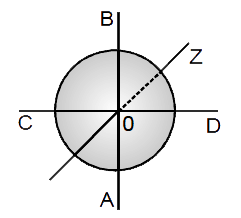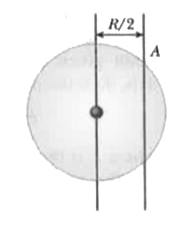Find the moment of inertia of a half uniform ring (mass m, radius r) about its center.
To find the moment of inertia of a half uniform ring about its center, we can follow these steps:
Step 1: Understand the Geometry
We have a half uniform ring with mass m and radius r. The ring is symmetric about the y-axis, and we will calculate the moment of inertia about the center of the ring, which is at the origin.
Step 2: Consider a Small Element
We can consider a small element of the ring at an angle θ with a small angular width dθ. The length of this small arc element is given by:
dL=rdθ
where dL is the length of the small arc.
Step 3: Determine the Mass of the Element
The total length of the half ring is πr (since the full circumference is 2πr). Thus, the mass per unit length λ of the ring is:
λ=mπr
The mass dm of the small arc element can be expressed as:
dm=λdL=mπr⋅(rdθ)=mπdθ
Step 4: Calculate the Moment of Inertia of the Element
The moment of inertia dI of this small element about the center is given by:
dI=r2dm=r2(mπdθ)=mr2πdθ
Step 5: Integrate to Find Total Moment of Inertia
To find the total moment of inertia I of the half ring, we need to integrate dI from θ=0 to θ=π:
I=∫π0dI=∫π0mr2πdθ
I=mr2π∫π0dθ=mr2π⋅(θ)π0=mr2π⋅π=mr2
Final Result
Thus, the moment of inertia of the half uniform ring about its center is:
I=mr2
---
We have a half uniform ring with mass m and radius r. The ring is symmetric about the y-axis, and we will calculate the moment of inertia about the center of the ring, which is at the origin.
We can consider a small element of the ring at an angle θ with a small angular width dθ. The length of this small arc element is given by:
dL=rdθ
where dL is the length of the small arc.
The total length of the half ring is πr (since the full circumference is 2πr). Thus, the mass per unit length λ of the ring is:
λ=mπr
The mass dm of the small arc element can be expressed as:
dm=λdL=mπr⋅(rdθ)=mπdθ
The moment of inertia dI of this small element about the center is given by:
dI=r2dm=r2(mπdθ)=mr2πdθ
To find the total moment of inertia I of the half ring, we need to integrate dI from θ=0 to θ=π:
I=∫π0dI=∫π0mr2πdθ
I=mr2π∫π0dθ=mr2π⋅(θ)π0=mr2π⋅π=mr2
Thus, the moment of inertia of the half uniform ring about its center is:
I=mr2
Topper's Solved these Questions
- RIGID BODY DYNAMICS - IBook:RESNICK AND HALLIDAYChapter:RIGID BODY DYNAMICS - IExercise:PROBLEMS
Explore 100 Videos
- RIGID BODY DYNAMICS - IBook:RESNICK AND HALLIDAYChapter:RIGID BODY DYNAMICS - IExercise:PRACTICE QUESTIONS (SINGLE CORRECT CHOICE TYPE)
Explore 43 Videos
- RIGID BODY DYNAMICS - IBook:RESNICK AND HALLIDAYChapter:RIGID BODY DYNAMICS - IExercise:PRACTICE QUESTIONS (INTEGER TYPE))
Explore 3 Videos
- RELATIVITYBook:RESNICK AND HALLIDAYChapter:RELATIVITYExercise:PRACTICE QUESTIONS (Integer Type)
Explore 5 Videos
- RIGID BODY DYNAMICS-IIBook:RESNICK AND HALLIDAYChapter:RIGID BODY DYNAMICS-IIExercise:PRACTICE QUESTIONS (Integer Type)
Explore 2 Videos
Similar Questions
Knowledge Check
For a uniform ring of mass M and radius R at its centre
Afield and potential both are zeroBfield is zero but potential is GMRCfield is zero but potential is −GM/RDmagnitude of field is GMR2 and potential −GMRMoment of inertia of a thin circular plate of mass M, radius R about an axis passing through its diameter is I. The moment of inertia of a circular ring of mass M, radius R about an axis perpendicular to its plane and passing through its centre is
A2IBI2C4IDI4
Find the moment of inertia of uniform ring of mass M and radius R about a diameter.

View SolutionFind moment of inertia of a uniform solid sphere (mass m, radius r) about a tangent.
View SolutionFind the moment of inertia of a uniform sphere of mass m and radius R about a tangent if the spheres (1) solid (ii) hollow?
View SolutionFind the moment of inertia of a uniform cylinder about an axis through its centre of mass and perpendicular to its base. Mass of the cylinder is M and radius is R.
View SolutionThe moment of inertia of a ring of mass M and radius R about PQ axis will be

View SolutionFind the moment of inertia of a solid cylinder of mass M and radius R about a line parallel to the axis of the cylinder and on the surface of the cylinder.
View Solution
